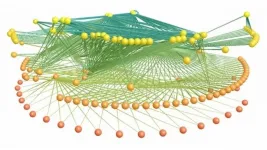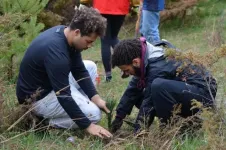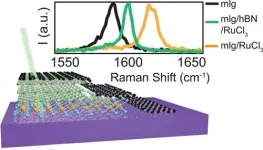Accounting for the gaps in ancient food webs
2021-01-14
(Press-News.org) If you want to understand an ecosystem, look at what the species within it eat. In studying food webs -- how animals and plants in a community are connected through their dietary preferences -- ecologists can piece together how energy flows through an ecosystem and how stable it is to climate change and other disturbances. Studying ancient food webs can help scientists reconstruct communities of species, many long extinct, and even use those insights to figure out how modern-day communities might change in the future. There's just one problem: only some species left enough of a trace for scientists to find eons later, leaving large gaps in the fossil record -- and researchers' ability to piece together the food webs from the past.
"When things die and get preserved as fossils, all the stuff that isn't bones and teeth and shells just decays," says the Santa Fe Institute's Vice President for Science Jennifer Dunne, a veteran food web researcher. "Organisms that are primarily soft-bodied, they usually just disappear from the record altogether."
A new paper by paleoecologist Jack Shaw, a PhD student at Yale University who led the study, Dunne and other researchers shines a light on those gaps and points the way to how to account for them. "The missing components of the fossil record -- such as soft-bodied organisms -- represent huge gaps in understanding ancient ecology, but we haven't thought extensively about how those gaps are affecting our inferences," Shaw says. "We're taking the fossil record at face value without critically thinking about how face value might not be robust and accurate."
Focusing on the absence of soft-bodied taxa in the fossil record, the study, published in Paleobiology on January 14, notes that accounting for these data gaps is vital for forming a more accurate picture of ancient food webs. By only looking at fossilized taxa, without accounting for the loss of soft-bodied organisms to the sands of time, for example, researchers might make the mistake of assuming the ecological community was structured differently and less stable than it actually was.
But by drawing on network theory, the researchers were able to show that the inclusion of soft-bodied organisms is vital for realistic depictions of ancient food webs. They found that ecological differences between soft- and hard-bodied taxa appear in the record of an Early Eocene food web, but not in much older Cambrian food webs, suggesting that the differences between the groups have existed for at least 48 million years.
"Geologists and biologists assume that soft-bodied and hard-bodied things have distinct life habits -- where they live or who they eat -- but we actually quantify it here using network analysis," Shaw says.
He and Dunne hope the study will help strengthen future research in the burgeoning field of ancient food web reconstruction. "This work is really important, because it's grappling with some of the fundamental uncertainty relating to the fossil record," says Dunne.
"The methodology can be applied to various other types of biases," not just the soft-bodied organism related bias, Shaw notes. "We're hoping to start being more critical of ancient food webs and perhaps opening them up to being more robust. A better grasp on how ancient food webs were affected by perturbations will allow us to make better predictions of what future ecosystems may look like."
INFORMATION:
[Attachments] See images for this press release:

ELSE PRESS RELEASES FROM THIS DATE:
2021-01-14
When three galaxies collide, what happens to the huge black holes at the centers of each? A new study using NASA's Chandra X-ray Observatory and several other telescopes reveals new information about how many black holes are furiously growing after these galactic smash ups.
Astronomers want to learn more about galactic collisions because the subsequent mergers are a key way that galaxies and the giant black holes in their cores grow over cosmic time.
"There have been many studies of what happens to supermassive black holes when two galaxies merge," said Adi Foord of Stanford University, who led the study. "Ours is one of the first to systematically look at what happens to ...
2021-01-14
The reproductive cycle of viruses requires self-assembly, maturation of virus particles and, after infection, the release of genetic material into a host cell. New physics-based technologies allow scientists to study the dynamics of this cycle and may eventually lead to new treatments. In his role as physical virologist, Wouter Roos, a physicist at the University of Groningen, together with two longtime colleagues, has written a review article on these new technologies, which was published in Nature Reviews Physics on 12 January.
'Physics has been used for a long time to study viruses,' says Roos. 'The laws of ...
2021-01-14
In the inaugural issue of the journal Nature Aging a research team led by aging expert Linda P. Fried, MD, MPH, dean of Columbia University Mailman School of Public Health, synthesizes converging evidence that the aging-related pathophysiology underpinning the clinical presentation of phenotypic frailty (termed as "physical frailty" here) is a state of lower functioning due to severe dysregulation of the complex dynamics in our bodies that maintains health and resilience. When severity passes a threshold, the clinical syndrome and its phenotype are diagnosable. This paper summarizes the evidence meeting criteria for physical frailty as a product of complex system dysregulation. ...
2021-01-14
Astronomers have curated the most complete list of nearby brown dwarfs to date thanks to discoveries made by thousands of volunteers participating in the Backyard Worlds citizen science project. The list and 3D map of 525 brown dwarfs -- including 38 reported for the first time -- incorporate observations from a host of astronomical instruments including several NOIRLab facilities. The results confirm that the Sun's neighborhood appears surprisingly diverse relative to other parts of the Milky Way Galaxy.
Mapping out our own small pocket of the Universe is a time-honored quest within astronomy, and ...
2021-01-14
NEW YORK (January 14) -- A new study co-authored by researchers from the Wildlife Conservation Society's (WCS) Global Conservation Program and the University of British Columbia (UBC) Faculty of Forestry introduces a classification called Resistance-Resilience-Transformation (RRT) that enables the assessment of whether and to what extent a management shift toward transformative action is occurring in conservation. The team applied this classification to 104 climate adaptation projects funded by the WCS Climate Adaptation Fund over the past decade and found differential responses toward transformation ...
2021-01-14
A wide breadth of behaviors surrounding oral sex may affect the risk of oral HPV infection and of a virus-associated head and neck cancer that can be spread through this route, a new study led by researchers at the Johns Hopkins Kimmel Cancer Center suggests. These findings add nuance to the connection between oral sex and oropharyngeal cancer -- tumors that occur in the mouth and throat -- and could help inform research and public health efforts aimed at preventing this disease.
The findings were reported Jan. 11 in the journal Cancer.
In the early 1980s, researchers realized that nearly all cervical cancer is caused by the human papillomavirus (HPV), a DNA virus from the Papillomaviridae family. Although about 90% of HPV infections ...
2021-01-14
The higher a person's income, the more likely they were to protect themselves at the early stages of the Covid-19 pandemic in the United States, Johns Hopkins University economists find.
When it comes to adopting behaviors including social distancing and mask wearing, the team detected a striking link to their financial well-being. People who made around $230,000 a year were as much as 54% more likely to increase these types of self-protective behaviors compared to people making about $13,000.
"We need to understand these differences because we can wring our hands, and we can blame and shame, but in a way it doesn't matter," said Nick Papageorge, the Broadus Mitchell Associate Professor of Economics. "Policymakers just need to recognize who is going ...
2021-01-14
Physicists at Washington University in St. Louis have discovered how to locally add electrical charge to an atomically thin graphene device by layering flakes of another thin material, alpha-RuCl3, on top of it.
A paper published in the journal Nano Letters describes the charge transfer process in detail. Gaining control of the flow of electrical current through atomically thin materials is important to potential future applications in photovoltaics or computing.
"In my field, where we study van der Waals heterostructures made by custom-stacking atomically ...
2021-01-14
ATLANTA--Compared to standard machine learning models, deep learning models are largely superior at discerning patterns and discriminative features in brain imaging, despite being more complex in their architecture, according to a new study in Nature Communications led by Georgia State University.
Advanced biomedical technologies such as structural and functional magnetic resonance imaging (MRI and fMRI) or genomic sequencing have produced an enormous volume of data about the human body. By extracting patterns from this information, scientists can glean ...
2021-01-14
Philadelphia, January 14, 2021--Based on preclinical studies of an investigational drug to treat peripheral nerve tumors, researchers at Children's Hospital of Philadelphia (CHOP) as part of the Neurofibromatosis Clinical Trials Consortium have shown that the drug, cabozantinib, reduces tumor volume and pain in patients with the genetic disorder neurofibromatosis type 1 (NF1). The results of the Phase 2 clinical trial, co-chaired by Michael J. Fisher, MD at CHOP, were published recently in Nature Medicine.
"This is the second class of drugs to demonstrate ...
LAST 30 PRESS RELEASES:
[Press-News.org] Accounting for the gaps in ancient food webs



